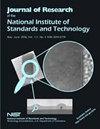腔增强自发参数下转换的背景和评述。
IF 1.3
4区 工程技术
Q3 INSTRUMENTS & INSTRUMENTATION
Journal of Research of the National Institute of Standards and Technology
Pub Date : 2019-08-15
DOI:10.1002/HTTPS://DOI.ORG/10.6028/JRES.124.019
引用次数: 28
摘要
近三十年来,非线性晶体中的自发参数下转换(SPDC)一直是量子通信应用中纠缠和相关单光子对生成的主力。然而,作为一种自然的宽带过程,SPDC与原子系综中非常窄的能量跃迁对接以实现量子存储器的能力最初受到限制,而量子存储器是量子中继器扩展量子通信范围所必需的。为了克服这一限制,通过将非线性晶体放置在谐振腔内来增强该过程。这种改进的工艺具有一些重要的优点,包括将产生的光子的光谱线宽缩小到腔的更亮的谐振模式,以及将腔的期望模式锁定到原子系综的目标跃迁频率的能力。本文概述了腔增强SPDC的原理,回顾了迄今为止使用该技术的工作,并举例说明了其中一种实现方式。本文章由计算机程序翻译,如有差异,请以英文原文为准。
Background and Review of Cavity-Enhanced Spontaneous Parametric Down-Conversion.
Spontaneous parametric down-conversion (SPDC) in a nonlinear crystal has been a workhorse for the generation of entangled and correlated single-photon pairs used for quantum communications applications for nearly three decades. However, as a naturally broadband process, the ability of SPDC to interface with the very narrow energy transitions in atomic ensembles for implementing quantum memories, which are needed for quantum repeaters to extend the reach of quantum communications, was initially limited. To overcome this limitation, the process was enhanced by placing the nonlinear crystal inside a resonating cavity. This modified process has some important advantages, including narrowing the spectral linewidth of generated photons into brighter resonant modes of the cavity, and the ability to lock the desired mode of the cavity to the targeted transition frequency of the atomic ensemble. This paper presents an overview of the principle of cavity-enhanced SPDC, a review of works to date using this technique, and an example of one of these implementations.
求助全文
通过发布文献求助,成功后即可免费获取论文全文。
去求助
来源期刊
自引率
33.30%
发文量
10
审稿时长
>12 weeks
期刊介绍:
The Journal of Research of the National Institute of Standards and Technology is the flagship publication of the National Institute of Standards and Technology. It has been published under various titles and forms since 1904, with its roots as Scientific Papers issued as the Bulletin of the Bureau of Standards.
In 1928, the Scientific Papers were combined with Technologic Papers, which reported results of investigations of material and methods of testing. This new publication was titled the Bureau of Standards Journal of Research.
The Journal of Research of NIST reports NIST research and development in metrology and related fields of physical science, engineering, applied mathematics, statistics, biotechnology, information technology.

 求助内容:
求助内容: 应助结果提醒方式:
应助结果提醒方式:


